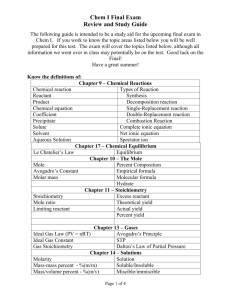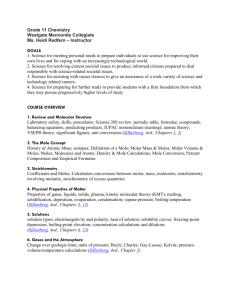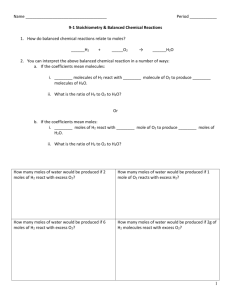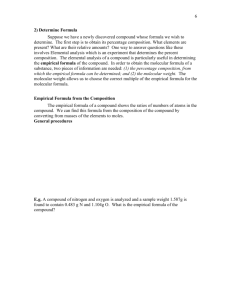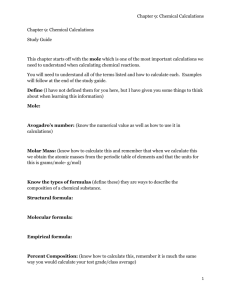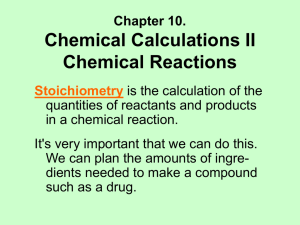Chapter 9 – STOICHIOMETRY
advertisement
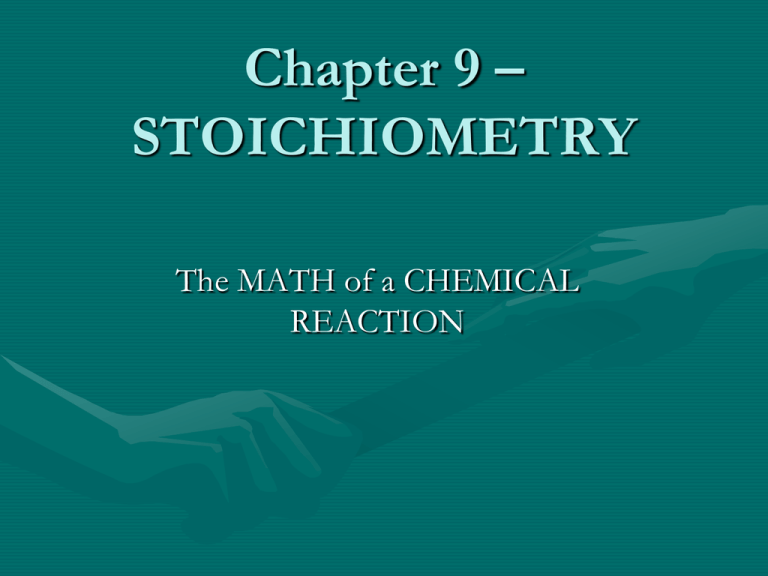
Chapter 9 – STOICHIOMETRY The MATH of a CHEMICAL REACTION 9.1 – Reaction Stoichiometry -Ratio of compounds in a reaction -YOU NEED A BALANCED CHEMICAL REACTION!! Examples: Al + O2 Al2O3 What this means: 4 MOLES Al react with 3 MOLES O2 to form 2 MOLES Al2O3 9.1 – Reaction Stoichiometry Example: C 2H 6 + O2 CO2 + H 2O 2 moles C2H6 reacts with 7 moles O2 to form 4 mole CO2 and 6 moles H2O 9.2 – Stoichiometry Calculations -You need to be sure your units are canceling algebra!! CAN ONLY SWITCH FROM ONE SUBSTANCE TO ANOTHER BY MOLES!! 9.2 – Stoichiometry Calculations Types of Calculations: 1. mole of one substance to mole of another Moles A Ratio from Balanced Equation Moles B Example: 4 NH3 + 3 O2 2 N2 + 6 H2O 9.4 mole NH3 = ? mole N2 1. Start with given 2. Multiply by a conversion factor 3. Conversion factor – mole ratio between substances 4. Plug into calculator 5. Remember units!!! Work: More Practice: 9.2 – Stoichiometry Calculations Types of Calculations: 2. mole of one substance to gram of another Moles A Ratio from Balanced Equation Moles B Molar Mass from Periodic Table Grams B Example: 4 NH3 + 3 O2 2 N2 + 6 H2O 4.35 mole NH3 = ? g H2O Work: More Practice: 9.2 – Stoichiometry Calculations Types of Calculations: 3. gram of one substance to mole of another Ratio from Balanced Equation Molar Mass from Periodic Table Grams A Moles A Moles B Example: 4 NH3 + 3 O2 2 N2 + 6 H2O 19.3 g NH3 = ? mol O2 Work: More Practice: 9.2 – Stoichiometry Calculations Types of Calculations: 4. gram of one substance to gram of another Molar Mass from Periodic Table Grams A Moles A Ratio from Balanced Equation Moles B Molar Mass from Periodic Table Grams B Example: 4 NH3 + 3 O2 2 N2 + 6 H2O 18.6 g O2 = ? g N2 Work: More Practice: More Practice: Limiting Reactants -Need a balanced equation! -You will be given information about more than one starting material -Limiting Reactant = The reactant which will run out first -Excess Reactant = The reactant which you have “more than enough of” Limiting Reactants Examples: -Making a Bicycle: 1 1 Stockroom Inventory: +2 frame 10 + 2 1 + 1 tires 18 + 1 handlebars 13 1 bike Limiting Reactants Examples: -Making a Bicycle: How many bikes can we make??? 1 1 +2 frame 10 + 2 1 + 1 tires 18 + 1 handlebars 13 How many bikes COULD we make from each component? 10 9 13 1 bike Limiting Reactants How many maximum could be made?? 9 *We picked the smallest value of the “could make” answers!! Which was the limiting reactant?? What are the excess reactants?? tires frames and handlebars Limiting Reactants Now a Chemistry Example: 3Fe + 4H2O Fe3O4 + 4H2 Starting materials: 24 g Fe and 20 g H2O 1.) What is the LR? 2.) How many grams Fe3O4 will be produced? Work: Percent Yield Compares the amount actually received in lab to the amount that was expected from math problem. Theoretical Yield = The amount expected. The number you calculate with pen and paper (stoich problem.) Actual Yield = The amount actually obtained (will be given!!!) % Yield = actual yield x 100 theoretical yield Percent Yield Example: Easy Harder: 3Fe + 4H2O Fe3O4 + 4H2 Starting materials: 14.2 g Fe and 27.8 g H2O After the experiment is complete: 17.3 g Fe3O4 are actually obtained What is % yield? Percent Yield Work: 3Fe + 4H2O Fe3O4 + 4H2 14.2 g Fe 27.8 g H2O % Yield

